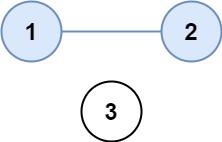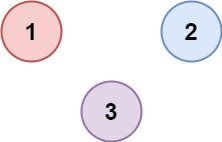Description
There are n cities. Some of them are connected, while some are not. If city a is connected directly with city b, and city b is connected directly with city c, then city a is connected indirectly with city c.
A province is a group of directly or indirectly connected cities and no other cities outside of the group.
You are given an n x n matrix isConnected where isConnected[i][j] = 1 if the ith city and the jth city are directly connected, and isConnected[i][j] = 0 otherwise.
Return the total number of provinces.
Example 1:

Input: isConnected = [[1,1,0],[1,1,0],[0,0,1]] Output: 2
Example 2:

Input: isConnected = [[1,0,0],[0,1,0],[0,0,1]] Output: 3
Constraints:
1 <= n <= 200n == isConnected.lengthn == isConnected[i].lengthisConnected[i][j]is1or0.isConnected[i][i] == 1isConnected[i][j] == isConnected[j][i]
Solution
Python3
class UnionFind:
def __init__(self, N):
self._parent = {}
self._size = {}
self.connected = N
def union(self, a, b):
a, b = self.find(a), self.find(b)
if a == b:
return
if self._size[a] < self._size[b]:
a, b = b, a
self._parent[b] = a
self._size[a] += self._size[b]
self.connected -= 1
def find(self, x):
if x not in self._parent:
self._parent[x] = x
self._size[x] = 1
while self._parent[x] != x:
self._parent[x] = self._parent[self._parent[x]]
x = self._parent[x]
return x
class Solution:
def findCircleNum(self, isConnected: List[List[int]]) -> int:
N = len(isConnected)
uf = UnionFind(N)
for i in range(N):
for j in range(N):
if isConnected[i][j] == 1:
uf.union(i, j)
return uf.connected